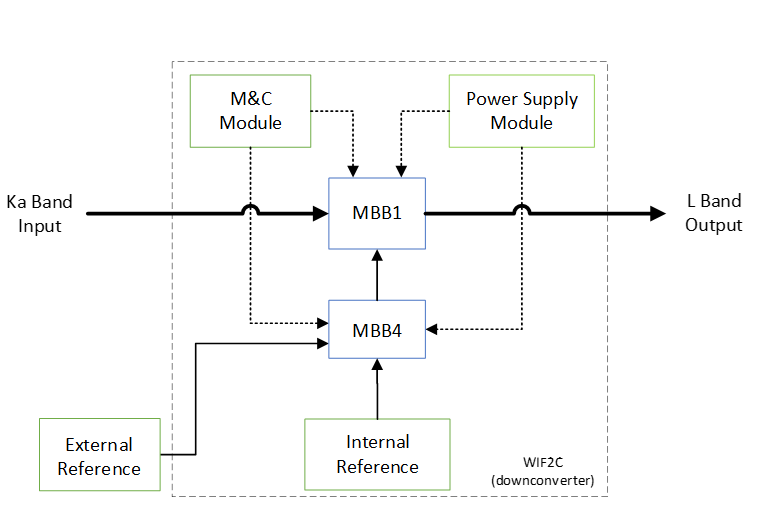-
StatusCompleted
-
Status date2025-10-22
-
Activity Code7C.067
The main objective of this Advanced Research in Telecommunications Systems (ARTES) technology phase project is the development of a partial prototype of a wideband integrated frequency down converter. It covers all necessary analysis and simulations to validate the design and the realization of one prototype to mitigate the risks before entering the product development phase.
The following Modular Building Blocks (MBB) are covered by that activity:
- MBB1: Frequency conversion module
- Ka-band frequency range (17.7 – 21.2 GHz)
- Down conversion to L-band
- 1 GHz bandwidth
- MBB4: Low phase noise local oscillator
- Local oscillator output of 11.35 – 12.6 GHz
- Tuneable to cover the Ka-band radio frequency (RF) input frequencies
The main challenges are:
- The design of a configurable solution covering the Ka band (17.7-21.2 GHz) to serve different telecommunications applications;
- The design of the down-conversion module meeting the flatness constraint of the frequency response in the used bandwidth
- The control of the spectral purity; minimising spurs of all kinds (external and internal sources, in-band and out of band);
- The design of a stable low phase noise local oscillator and its distribution to all frequency conversion stages.
The WIF2C product is modular and expandable, such that it can be scaled and deployed in different configurations (up or down frequency converter, multi or single frequency band, multiple channels) and form factors (19-inch rack unit indoor, outdoor enclosure, small form factor plug-in module) to match gradual operational requirements of the missions deployed. It features a tuneable (fine steps) low phase noise local oscillator capable to track any RF signal issued from the Ka band (17.7 GHz to 21.2 GHz).
Three different use cases (operational scenarios) are envisaged for the final WIF2C product issued from the product phase:
- Ground stations on traditional mechanically steerable dishes;
- Next generation ground stations based on phased array architectures;
- Radar applications.
WIF2C is a New Generation Wideband Integrated Flexible Frequency Converter for low Earth orbit (LEO) / medium Earth orbit (MEO) / geostationary orbit (GEO) satellite covering the broadband satellite communication market demands.
It performs the following main functions:
- Frequency conversion;
- Signal amplification and conditioning;
- Image rejection, spurious, harmonics; and out of band signals filtering;
- Local oscillator and reference signals generation;
- Monitoring and control.
WIF2C provides the necessary RF interfaces, frequency reference and control interconnections next to frequency conversion stages. It can be customized to support multiple frequency bands. WIFC2 is based on its own internal local oscillator stage that can be tuned dynamically to support different satellites.
Key characteristics are as follows:
- Input RF frequency 17.7 – 21.2 GHz
- Output RF frequency in L-Band (1 GHz – 2 GHz)
- Frequency step: 100 Hz
- Input power: -50 to -30 dBm
- Gain: 30 dB adjustable by 0.5 dB steps
- Phase Noise
- < -78/-80 dBc/Hz @ 100 Hz
- < -88/-90 dBc/Hz @ 1 kHz
- < -94/-96 dBc/Hz @ 10 kHz
- < -103/-105 dBc/Hz @ 100 kHz
- < -108/-110 dBc/Hz @ 1 MHz
- Noise Figure < 15 dB
- SFDR < -65 dBc
- Independent spurious levels < -85 dBc
- Return loss > 18 dB
- No spectrum inversion
The top level block diagram of this WIF2C prototype developed through the execution of this Technology phase project is illustrated by the following figure:

- MBB1: Frequency-down conversion module
- MBB4: Low-phase noise (tuneable) local oscillator
MBB1 and MBB4 are both synchronized by means of an internal or external frequency reference. MBB1 takes as input the RF signal from Ka-band (17.7 – 21.2 GHz) and down-converts it by mixing it with its own low phase noise local oscillator MBB4. The power supply source comes from a reference stable power supply unit in the lab.
This activity is organized in 2 phases as followed:
- Definition Phase
- User & Technical Requirements Definition
- Technology Phase
- Preliminary Design
- Detailed Design
- Assembly, Integration and Test
- Final Verification
- Project Closure
The project was completed in October 2025. The prototype, including both the downconverter (MBB1) and its own low-phase noise local oscillator (MBB4), has been realised and verified.



